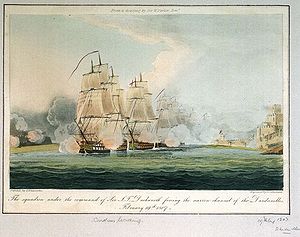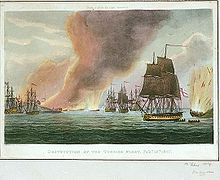- Dardanelles Operation
-
For the World War I operations in the Dardanelles, see Dardanelles Campaign.
Dardanelles Operation Part of the Anglo-Turkish War 
The squadron under the command of Sir J T Duckworth forcing the narrow channel of the Dardanelles, February 19th 1807, by Thomas WhitcombeDate 19 February 1807 Location Dardanelles Result Ottoman victory Belligerents  British Empire
British Empire Ottoman Empire
Ottoman EmpireCommanders and leaders John Thomas Duckworth Sultan Selim III Strength 8 ships of the line, 2 frigates, 2 bomb ships, 1 transport 14 ships of the line, 9 frigates, a dozen brigs and gunboats, several hundred Ottoman siege cannons, and some modern bronze pieces Casualties and losses 42 killed, 235 wounded, and 4 missing[1] Unknown - Dardanelles Operation
- Battle of the Dardanelles
- Arpachai
- Athos
- the Danube
The Dardanelles Operation was the Royal Navy's unsuccessful attempt to impose British demands on the Ottoman Empire as part of the Anglo-Turkish War (1807-1809).
In 1806, the French envoy Sebastiani had been dispatched to Constantinople with orders to bring about Turkey's re-entry into the war. Sultan Selim III set about preparations for war with Russia after positively receiving Sebastiani. The Russian emperor, Alexander I, was alarmed by these developments as he had already deployed a significant force to Poland and East Prussia to fight the advancing French forces under Emperor Napoleon I. Alexander requested British assistance in keeping Turkey out of the war.
The British army was far too small and inadequate to impose the will of the Coalition on the Ottomans, so it naturally fell to the powerful Royal Navy to meet Russia's requests. The ships immediately available for the task were HMS Canopus, HMS Standard, HMS Thunderer, HMS Glatton, and the two bomb ships Cuthbert Collingwood, commander-in-chief of the British Mediterranean Fleet, sailed for the Dardanelles and made preparations for the upcoming assault.
In the meantime, the British ambassador to Constantinople, Arbuthnot, demanded that the Ottoman government evict Sebastiani, and added that should the Ottomans resist the ultimatum, the Mediterranean fleet would attack.
The actual force that had been chosen by Collingwood to carry out the operation was small—only eight ships-of-the-line and four frigates. In addition, four Russian ships-of-the-line under Admiral Dmitry Senyavin were sent to support the British, but did not join Duckworth until after the exit from Dardanelles was made. Admiral Duckworth, who commanded the British, was under orders to bombard Constantinople and seize the Turkish battle fleet.
Contents
Background
In anticipation of a war between Russia and Turkey, Britain had sent Sir Thomas Louis from Cadiz on 2 November 1806 into the Mediterranean Sea. He reached Tenedos, near the Dardanelles Strait, on 21 November, made a brief trip to Constantinople and returned to the Straits. Turkey had declared war on Russia on 30 December 1806, and Britain sent Admiral Sir John Duckworth in Royal George 100 from Cadiz on 15 January 1807 into the Mediterranean Sea. Picking up Windsor Castle 98 guns and Repulse 74 guns from Gibraltar and Pompée 74 and Ajax 74 from Malta as replacements for the Russian fleet under Seniavin, which was still in the Adriatic, Duckworth proceeded to Tenedos. Despite the British ultimatum, on December 27 Selim declared war on Russia. On 29 January 1807, the frigate Endymion of 40 guns left Constantinople, evacuating the British ambassador and all British residents. A formal declaration of war had not yet been sent by London and the two powers were still technically allied.
On February 10, Duckworth's fleet concentrated at the mouth of the Dardanelles. It met Louis's ships and returned to Tenedos on 1 February, where Duckworth's ships met up. Still not technically at war, the Turkish delayed Duckworth with token negotiations. The presence of British and Russian vessels at the mouth of the Dardanelles caused Sebastiani and his French engineering officers to begin the improvement of the Turkish shore batteries.
The battle
On 11 February, the fleet, with Duckworth in command, left Tenedos, but for a week could not enter the Straits because of lack of wind. Ajax caught fire on 14 February, ran aground on Tenedos, and blew up on 15 February.
Finally, on 19 February the ships sailed up the Dardanelles, where they were fired on by the forts at the entrance (fire was returned by the bombs), then the castles further up (fire was returned by the fleet). However, the absence of significant numbers of Turkish troops, owing to the end of Ramadan, meant the batteries were ineffective and the fleet quickly reached the Sea of Marmara.
Just above the castles lay a 64-gun ship, frigates of 40, 36, 36, and 32 guns, sloops of 22, 18, 10 and 10 guns, 2 brigs and 2 gunboats. As the British fleet approached, one of the brigs left and sailed further up for Constantinople. After Royal George passed, anchoring some 3 miles further up, Pompée, Thunderer, Standard, Endymion and Active attacked the Turkish vessels and a new fortification being built nearby. 1 sloop and 1 gunboat were captured and others forced ashore and destroyed by British boats. Duckworth then ordered marines under Edward Nicolls to land and seize the shore batteries, and as the Turkish gunners tried to flee from an island they called Brota,[3] the Royal Marines captured two guns.[1]
At 5pm the fleet sailed for Constantinople, leaving Active behind to finish up. British casualties in this action were 10 killed and 77 wounded. After suffering extensive damage, Duckworth withdrew without ever attempting a bombardment of Constantinople.
One of the guns fired during this engagement of the British Fleet was an ancient 18.6 ton cast bronze piece with 63 cm diameter stones used for projectiles, the Dardanelles Gun. The piece had last seen service about 350 years prior during the Siege of Constantinople in 1453 and now resides in Fort Nelson.
Aftermath
Duckworth sailed off Constantinople for a week and a half, hoping the Turkish fleet would come out and fight, but it did not, so, releasing the sloop on 2 March, he returned through the Dardanelles to Tenedos on 3 March. On the way, he was attacked again by the fortifications, losing 29 killed and 138 wounded. At Tenedos he was met by Seniavin, who had left Corfu on 22 February.
He did not make a second attempt on the Dardanelles—a decision that earned him criticism, but was probably reasonable considering the powerful shore batteries. An attempt to seize the Turkish fleet would have probably failed and resulted in much higher British casualties.
The entire operation was a failure, resulting in heavy losses of 42 killed, 235 wounded, and 4 missing.[1] Long after France and Russia had made peace and Senyavin had defeated the Turkish fleet at Dardanelles on 10–11 May 1807, the Ottomans would remain at war with their northern neighbour, draining a significant portion of the Russian army, which also became involved in operations against Sweden in the Finnish War and later in the resumption of hostilities against France in 1812.
Fleet
The Royal Navy fleet included
Vanguard Division commanded by Rear-Admiral Sir Thomas Louis
- HMS Canopus 80-gun third-rate (Flag-Captain F.W. Austin)[4][dubious ]
- HMS Endymion 40-gun 24-pounder fifth-rate frigate (Captain Hon. T.B. Capel) [4]
- HMS Ajax 74-gun third-rate (Captain Hon. H. Blackwood) [4]
Main Division commanded by Vice-Admiral Sir John Thomas Duckworth
- HMS Royal George 100-gun first-rate (Flag-Captain Richard Dalling Dunn) [4]
- HMS Windsor Castle 98-gun second-rate (Captain C. Boyles) [4]
- HMS Repulse 74-gun third-rate (Captain Hon. A.K. Legge)[5]
- HMS Active 38-gun fifth-rate (Captain Moubray)[6]
Rear Division commanded by Rear-Admiral Sir Sydney Smith[7]
- HMS Standard 64-gun third-rate (Captain Harvey) [6]
- HMS Thunderer 74-gun third-rate (Captain Talbot)[6]
- HMS Pompée 74-gun third-rate (Flag Captain Richard Dacres)[6]
- HMS Lucifer bomb vessel (Captain Elliot)[8]
- HMS Meteor bomb vessel (Commander James Collins)[9][10]
- HMS Madras (store ship) 54-gun (Captain Charles Marsh Schomberg) [4]
- edit] Citations and notes
- ^ a b c The Royal Hospital School, Holbrook cannon
- ^ p.187, Brenton
- ^ known as Proti by the Greeks, and now known as Kinali (Kinaliada), position 40º 55’N
- ^ a b c d e f p.186, Brenton
- ^ p.51, Howard
- ^ a b c d pp.15-20, Howard
- ^ commanding the rear division, pp.15-20, Howard
- ^ p.74, Howard, p.136, Duckworth in Report No6
- ^ p.74, Howard
- ^ Meteor's main 13-inch mortar split in two on first firing, p.143, Duckworth, No.6 Report
- ^ joined at Cape Matapan on the 6 February, p.187, Brenton, but not given by Smith because it had acted as a message ship, and had rejoined the squadron on 3 March from Messina via Malta
- ^ p.186, Brenton, but not given by Smith
References
- Howard, Edward, Memoires of Admiral Sir Sidney Smith, K.C. B., & c., Volume 2, Adamant Media Corporation, 2003
- Brenton, Edward Pelham, The Naval History of Great Britain, from the Year MDCCLXXXIII. to MDCCCXXXVI.: From the Year MDCCLXXXIII. to MDCCCXXXVI, Volume II, Henry Colburn Publisher, London 1837
- Duckworth to Collingwood, Report No6 on the Loss sustained on the Island of Prota, Naval papers respecting Copenhagen, Portugal, and the Dardanelles, presented to parliament in 1808, by Parliament, London 1809
- Finkel, Caroline, Osman's Dream, (Basic Books, 2005), 57; "Istanbul was only adopted as the city's official name in 1930..".
External links
Categories:- Naval battles of the Anglo-Turkish War (1807-1809)
- Conflicts in 1807
- Dardanelles
Wikimedia Foundation. 2010.

